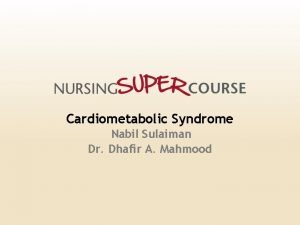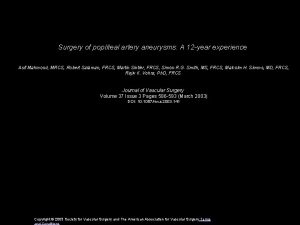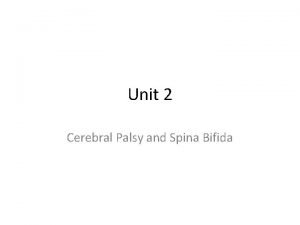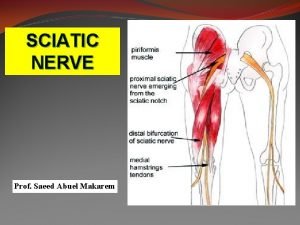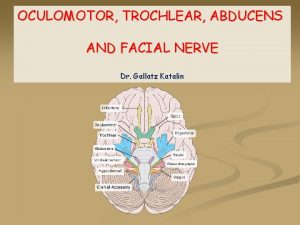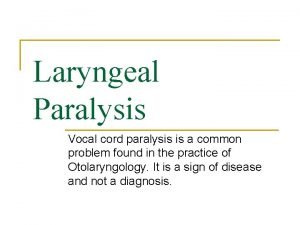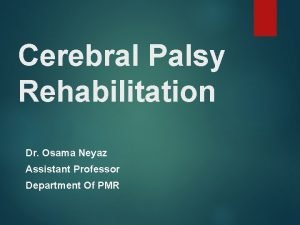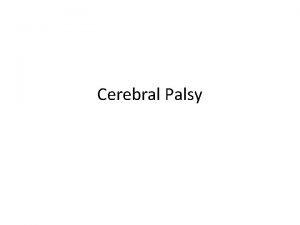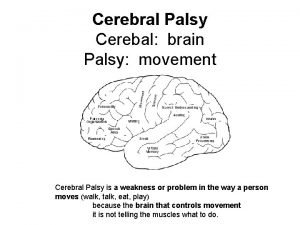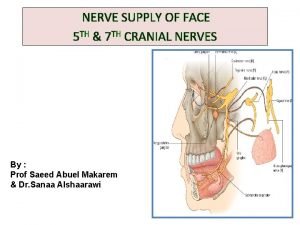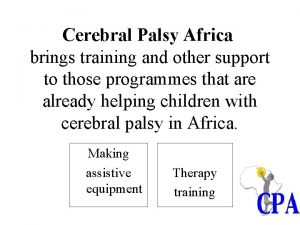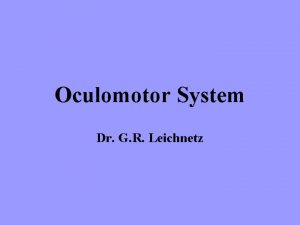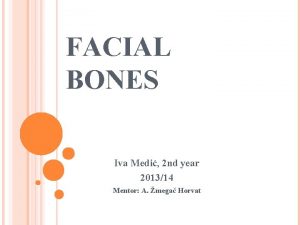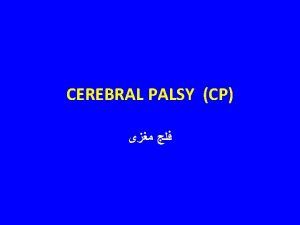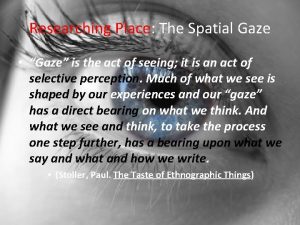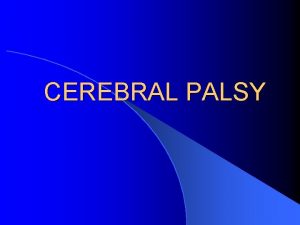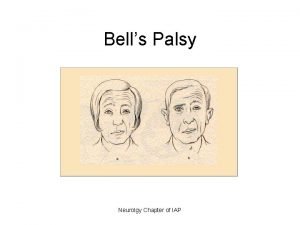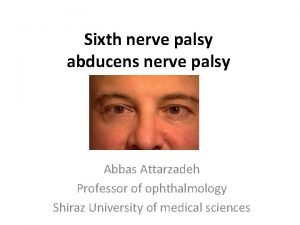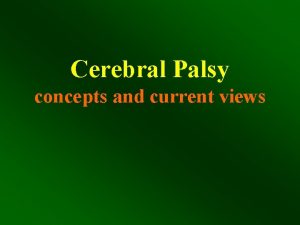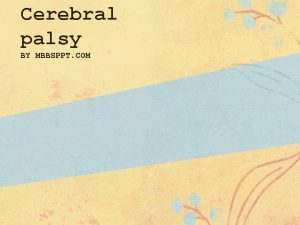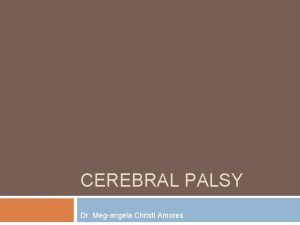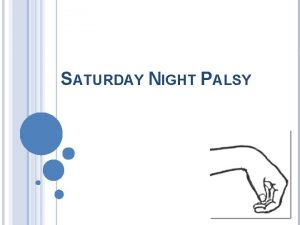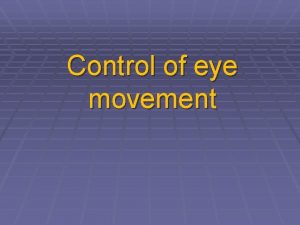Gaze palsy Mahmood J Showail The control of
































- Slides: 32


Gaze palsy Mahmood J Showail

� The control of eye movement has three components �The supranuclear pathway (from the cortex and other control centers in the brain to the ocular motor nuclei in the brainstem) �The ocular motor nuclei infranuclear pathway from the ocular motor nuclei to the peripheral nerve, neuromuscular junction, and extraocular muscles


� Supranuclear structures coordinate the action of extraocular muscles and muscle groups and control two types of eye movements: �conjugate version movements, in which both eyes move in the same direction �vergence movements, in which both eyes move in opposite directions, turning either in (convergence) or out (divergence).

� What �A does “Gaze Palsy” mean ? ? gaze palsy is an eye movement abnormality in which the two eyes move together but have limited movement in one direction

Gaze palsies are caused by � malfunction of one of the "gaze centers" (cortical and brainstem regions responsible for conjugate gaze) cortical gaze center Brainstem gaze center � interruption Supranuclear gaze palsy of the pathways leading from them. ( e. g isolated nerve palsy)

� The patient with supranuclear palsy is unable to move both eyes past the midline in one direction, and the eyes usually are held fixed and turned toward the opposite side by the opposing extraocular muscles. � It involves gaze centers for the control of �Horizontal movments �Vertical movments

� The patient with horizontal gaze palsy typically is unable to move either eye beyond the midline in one direction. � The eyes are deviated constantly to the opposite side, and the patient must turn his or head toward the side with the gaze palsy to fixate an object that is directly in front of him or her

� The signal for horizontal gaze originates in the contralateral frontal lobe for fast eye movements (saccades) and in the ipsilateral parieto-occipitotemporal region for smooth pursuit � For Horizontal gaze, impulses passes through the pontine paramedian reticular formation (PPRF), adjacent to 6 th nerve nuclues. � The (PPRT) activates the ipsilateral 6 th nerve nucleus and therby innervates the lateral rectus. � The 6 th nerve nucleus also communicate with the contralateral medial rectus (occulomotor) subnucleus via the medial longitudinal fasiculus (MLF).

Schematic representation of control of horozontal eye movment; PPRF; pontine paramedial reticular formation, MLF; medial longitudinal fasiculus VN: vestibular nucleus

(Horizontal gaze palsy usually is caused by contralateral frontal or ipsilateral pontine lesion ). � A horizontal gaze palsy to the ipsilateral side occurs in pontine lesions affecting the abducens nucleus and/or the PPRF. � Lesions of the MLF result in internuclear ophthalmoplegia (INO) � Lesions of the MLF plus the ipsilateral abducens nucleus and/or PPRF result in the one-and-a-half syndrome.

� Frontal lobe lesions � Epileptogenic lesions in the frontal eye fields � Eye deviation to the side of the hemiparesis ("wrong way eyes") Mesencephalic lesions � Contralateral selective saccadic palsy Hemorrhages deep in a cerebral hemisphere, particularly the thalamus � Acquired ocular motor apraxia (inability to generate voluntary movements) Lesions in the corona radiata adjacent to the genu of the internal capsule � Unilateral or bilateral increased saccade latencies Hypometria (shortened range) for contralateral saccades Saccadic slowing Bilateral parietal lesions � Transient deviation of the eyes and head to the contralateral side H ead and eye movements toward the same side during a seizure Unilateral parietal lesions � Defect in generating voluntary saccades Transient ipsilateral horizontal gaze deviation acutely Gaze palsy overcome with the oculocephalic (doll's eye) maneuver or caloric stimulation Paresis of contralateral saccades Supranuclear contralateral gaze palsies associated with ipsilateral oculomotor palsies Pontine lesions affecting the abducens nucleus and/or the PPRF Ipsilateral conjugate gaze palsy Doll's eye maneuver or cold caloric stimulation usually does not overcome gaze palsy Bilateral horizontal gaze palsies with bilateral lesions

� � Patient with Lt gaze palsy and Lt 7 th n palsy due to acute pontine heamorrhage he was able to minimally abduct the Rt eye but otherwise was unable to look to the left because of involvment of abducent nucleus on the left side.

� In patients with pontine lesions involving the PPRF or sixth nerve nucleus, the eyes may be deviated away from the side of the lesion. Thus, patients who are unable to move either eye beyond the midline to the left may have a left pontine lesion, and the eyes are deviated to the right. � The patient may have partial horizontal gaze movement if the damage to the pontine structures is only partial

� pontine lesions usually can be differentiated from supranuclear lesions in the frontal lobe by the oculocephalic or doll's eyes maneuver. � Passive horizontal rotation of the head directly stimulates the sixth nerve nucleus via the vestibulo-ocular reflex and will overcome gaze palsies induced by frontal lobe lesions but will not overcome gaze palsies caused by pontine nuclear and infranuclear lesions

� Horizontal gaze palsies are caused by ischemia and infarction, hemorrhage, vascular malformations, tumors, demyelination, trauma, or infections � MRI should be performed with attention given to the dorsal pons. � EEG should be performed if sezuire disorder is suspected

� INO (medial longitudinal fasciculus syndrome) is caused by MLF lesions (demylination, vascular disease, trauma or brainstem tumors ) � Such lesions permit the horizontal gaze center to communicate with the sixth nerve nucleus but not the contralateral third nerve nucleus.

� The features of right INO include: �Adduction deficit of Rt eye on attempted Lt gaze �Horozontal jerk nystagmus of abducting Lt eye �Normal Rt gaze �Upbeat & tortional nystagmus “may be present” �Convergence preserved

� Bilatral INO is usually due to demylination, with upbeat nystagmus on upgaze and down beat nystagmus on down gaze a constant feature. Bilateral INO a. Right gaze b. Left gaze

� MRI � may help in the diagnosis of INO. It may show abnormal high-signal intensity in the mid pons corresponding to the right medial longitudinal fasciculus.

� Myasthenia gravis and a partial third nerve palsy involving the medial rectus muscle both can be mistaken for INO. � Patients with ptosis, variability, or fatigue should be evaluated for myasthenia gravis � Ptosis, pupil involvement, involvement of other extraocular muscles, and absence of nystagmus in the abducting eye should suggest the diagnosis of third nerve palsy

� Patients with the one-and-a-half syndrome have horizontal gaze palsy when looking to one side (the "one") and impaired adduction (INO) when looking to the other (the "and-ahalf") � It is caused by pontine paramedian reticular formation (PPRF) lesion extending to the medial longitudinal fasiculus (MLF).

� Features of right sided one-and-a-half syndrome include: �Gaze palsy on attempted Rt gaze �Adduction deficit on attempted Lt gaze �Abduction of the Lt eye is the only normal horizontal movment � Stroke and multiple sclerosis are the main causes of this rare syndrome, but it can be caused by any structural lesion in the dorsal pons.

� Vertical eye movment are generated in the rostral interstitial nucleus of the medial longitudinal fasiculus(MLF) which consist of paired nuclei �With lateral portion of each initiating upgaze �The medial portion initiating downgaze

� Vrtical gaze palsy include the follwing: �Parinaud syndrome �Progressive supranuclear palsy �Skew deviation � Paralysis of upward vertical gaze is the most common vertical gaze palsy, followed by paralysis of both upward and downward gaze, and finally paralysis of downward gaze alone

� This syndrome occures in dorsal midbrain lesion that involve rostral interstitial nucleus of the MLF & the 3 ed nuclear complex. � Causes : �Demylination �Vascular disease �Aqueduct stenosis (hydrocephalus) �Arteriovenous malformation �tumors

� Features: �Upgaze disturbance �Convergence-retraction nystagmus �Light-near dissociation �Lid retraction �Convergence paralysis

� This is a progressive neurodegenerative condition which affects the elderly. � It initially impairs downgaze, subsequently upgaze become affected , followed by loss of horozontal, then saccadic and pursuit eye movements. � Patients may also develop pseudobulbar palsy, parkinsonism and dementia.

� These are usually small vertical tropias that can occur following brainstem or cerebellar lesion. � The vertical deviation is usually concomitent and ipsilateral to the side of the lesion. � They are usually assocaiated with other features that allow localization as �Unilateral INO “in pontine lesion” �Horner syndrome “”in medullary lesion”

� BCSC, American Academy of Ophthalmology 2004 -2005 � Training in Ophthalmology- the essential clinical curriculum, 2009 � Up to Date, Database � www. emedicine. com

 Pprf mlf pathway
Pprf mlf pathway Male gaze vs female gaze
Male gaze vs female gaze Mahmood ul hassan islamic aid
Mahmood ul hassan islamic aid Quality management assignment
Quality management assignment Kaleel mahmood
Kaleel mahmood Shabkhez mahmood
Shabkhez mahmood Abdullah nabil mahmood
Abdullah nabil mahmood Ashfaq mahmood
Ashfaq mahmood Mahmood haddara
Mahmood haddara Bleibel
Bleibel Mahmood rahman md
Mahmood rahman md Dr qudsia mahmood
Dr qudsia mahmood Dr huma rashid
Dr huma rashid Mahmood shafqat sbp
Mahmood shafqat sbp Gross motor function classification system
Gross motor function classification system Cerebral palsy vs spina bifida
Cerebral palsy vs spina bifida Bulbar palsy
Bulbar palsy Sciatic nerve sensory distribution
Sciatic nerve sensory distribution Oculomotor nerve
Oculomotor nerve Fisioterapi
Fisioterapi Semon law
Semon law Vagus nerve palsy
Vagus nerve palsy Cerebral palsy research network
Cerebral palsy research network Baclofen for cerebral palsy
Baclofen for cerebral palsy Extreminites
Extreminites Cerebral palsy mild
Cerebral palsy mild Cerebral palsy
Cerebral palsy Multiple cranial nerve palsy adalah
Multiple cranial nerve palsy adalah Face nerve supply
Face nerve supply Cerebral palsy africa
Cerebral palsy africa Umnl vs lmnl
Umnl vs lmnl Pprf mlf pathway
Pprf mlf pathway Facial palsy
Facial palsy






